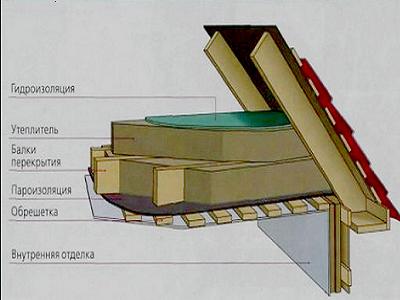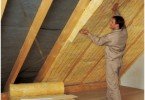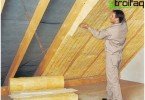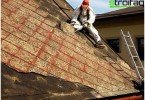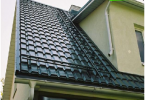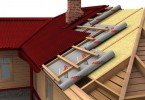How to properly insulate the roof of the house
One of the main conditions that affect the comfort of a house or a cottage is a warm, reliable and durable roof. It should retain heat well, protect it from moisture, protect it from the wind. When solving such a problem as insulating the roof, one should not save on the materials used. The roof is exposed to severe conditions, experiencing large temperature changes, the effect of precipitation, significant physical stress under the influence of wind.
Content
- Highlights of roof insulation
- Materials for insulation of the roof of the house
- How to insulate a flat roof
- How to insulate a pitched structure about roof insulation in detail
Highlights of roof insulation
Roof insulation is one of the important stages of insulation of the building as a whole. It is the final construction of the building that performs the main function of protecting the interior from adverse external influences. High-quality thermal insulation of the roof will provide tangible cost savings during the further operation of the living room, reducing heating costs. After all, about 20-30% of heat loss occurs through the roof.
When deciding on how to properly insulate the roof of a house, first of all, you should decide on the function of placing the attic. If it is not planned to make the attic a living room, then it is not necessary to insulate the roof from the inside. In this situation, only the attic floor should be well insulated to protect the room on the top floor from the effects of cold and heat loss. In a situation when a residential attic will be built in the attic, insulating the roof from the inside is a must.
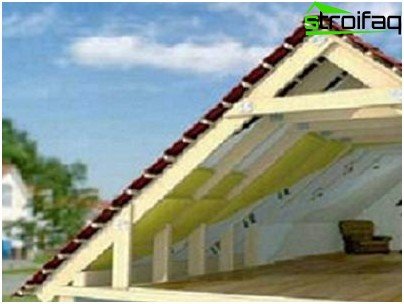
The attic is insulated if it is intended to be used as a living room
The way the work is performed also depends on the roof structure and the stage at which the insulation is carried out. The design can be pitched or flat, for each of them has its own characteristics when performing work. When choosing a method, the current stage of construction should be taken into account, since it is preferable to insulate the roof of the house at the design stage. The technology of the work is the same for both a wooden building and a brick.
It should be noted that before you insulate the roof of a wooden house, you need to carefully examine all the details of the roof, rafters for moisture, signs of decay and various damage. Wooden structures must be treated with an antiseptic, severely damaged areas must be replaced. Roof wiring components also require careful inspection..
Materials for insulation of the roof of the house
The modern market offers a huge selection of materials for insulation, the most common include fiberglass and polystyrene boards, foam concrete, foamed glass, mineral wool boards. Each type of insulation is characterized by different thermal conductivity, vapor permeability, strength and other properties. Mineral wool slabs are widely used, which differ favorably among other heaters in their quality characteristics. Their use is acceptable for most types of roofs..
Mineral wool plates are positioned as a fire-resistant material with low heat conductivity, good waterproofing and sound-absorbing properties. They practically do not deform during operation.
How to insulate a flat roof
To warm a flat roof, two methods are used:
- The principle of a rolling ceiling – insulation is laid on top;
- The principle of a false ceiling – insulation is lined with the inner surface of the ceiling.
Performing insulation work from the outside is a simpler and more convenient option. Several key points should be taken into account, among which it is necessary to single out the ability of the supporting structure to support the weight of the roofing material and insulation. It is possible that warming by the principle of a rolling ceiling will be enough to achieve comfortable living conditions in the house. Priority work on this method is more appropriate in the circumstances. Operation of the room in the cold season will allow us to conclude whether it is worth doing insulation from the inside, based on the principle of a false ceiling.
To insulate the outside of a roof with a flat shape, it is better to use basalt mineral wool. The choice of quality materials is especially important at this stage, since it is impossible to properly insulate the roof without this component.
Phased insulation of a flat roof occurs in the following sequence:
- A vapor barrier film is used to lay a layer that serves as a vapor barrier;
- On top of the film, a layer of thermal insulation from mineral wool plates is arranged;
- Waterproofing is laid in the form of a roll coating of roofing material, synthetic materials;
- Laying bulk material – insulation.
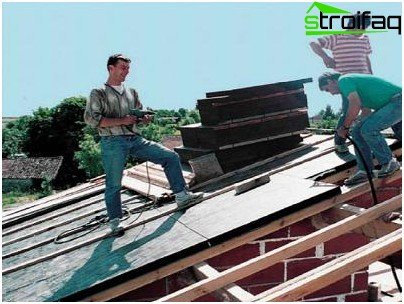
Insulation of a flat roof outside
Important! If the work is carried out during the period of precipitation, then it should be noted that the waterproofing coating must be immediately laid on the insulation, not allowing the latter to be covered with water, snow, ice. For large areas, measures must be taken to prevent precipitation from entering the roof surface..
Before starting work on the insulation of the roof, it is necessary to thoroughly clean the surface from dust and debris. If there are large irregularities, alignment may be required. Thermal insulation boards are glued using special cold mastic or glue. To achieve uniformity of the coating, it is necessary to lay mineral wool with half overlapping seams. Laying an additional layer of slabs is allowed to improve thermal insulation, while the slabs are placed “in a run-up”, and the joints are glued with tape. Using this technology avoids the appearance of “cold bridges”.
Recently, the fire method of laying waterproofing has been spreading. Cement-sand screed is laid on slabs of mineral wool more than three centimeters thick. After the concrete becomes durable, the work surface is cleaned of dirt and excess sag. The waterproofing carpet adheres under short-term exposure to fire without changing its protective properties. Laying of the material is carried out with an overlay of ten centimeters, which ensures the strength and tightness of the coating.
How to insulate a pitched structure
The pitched roof of houses or cottages often serves as the basis for creating an attic, which allows you to get additional square meters of living space. To insulate the attic from the inside are more stringent requirements.
The design of the insulated roof was called “roofing cake” due to the fact that it consists of several layers: a ventilation circuit under the coating, a waterproofing layer, another ventilation circuit (not always arranged), a heat-insulating layer and vapor barrier.
Waterproofing allows you to protect your home from moisture. When water gets under the roof, the insulation begins to lose its properties, wood structures begin to rot. In addition, the air under the insulated roof and on the street can vary significantly, the temperature difference causes condensation of moisture in the air on cold structures. Condensation may also occur inside the insulation, but the arrangement of ventilation circuits allows this to be avoided. Under the influence of the supply air, water vapor is removed from under the roof without condensation. A waterproofing layer covers construction logs and is attached to them with a stapler.
The presence of a ventilation circuit on the roof is a prerequisite for its functioning. The intake of fresh air must be arranged through a gap located on the overhang of the cornice, the hood is drawn through the ventilation device on the slope or ridge of the roof. It should be noted that all components of the structure should be ventilated. The ventilation device does not cause any problems for ordinary gable roofs. For roofs with intricate geometry, this task is faced with certain difficulties, since the free movement of air is prevented by various obstacles: ventilation shafts, chimneys, windows and other structural elements.
The next layer is insulation. The main characteristics of the material, affecting the quality of ongoing insulation work, are thermal conductivity and rigidity. The material must keep its shape, not deform under the influence of environmental conditions.
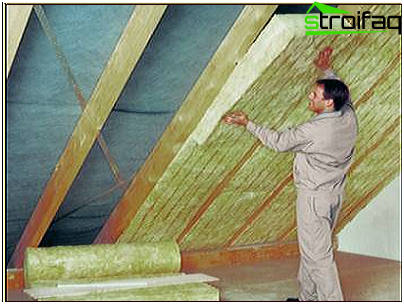
Insulated pitched roof insulation
A vapor barrier layer is attached to the insulation layer, attached to the rafters. As a material for its device, a building membrane film is usually used.
The final step in the insulation of the roof is the decoration of the “roofing cake” from the inside. The finished surface should be sheathed with drywall or chipboard for further wallpapering or other finishing work.
Roof insulation is an important component of the construction process, which allows to achieve comfortable living conditions. Proper execution of the work will provide an increase in the period of perfect operation of the entire roof structure, eliminating the need for unnecessary repairs.


